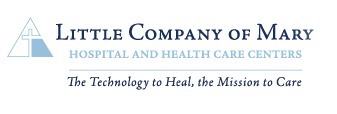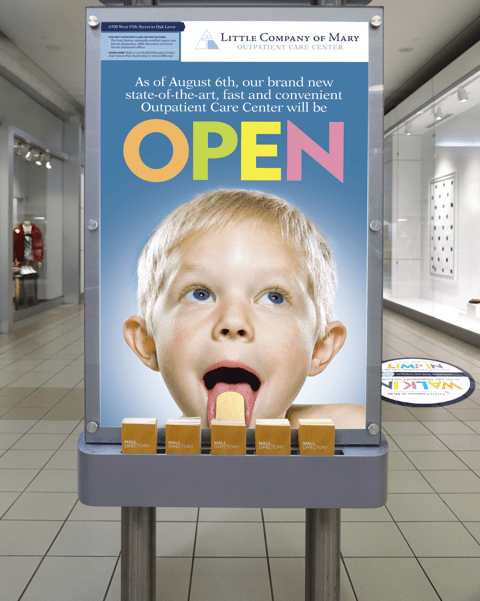The Power of Hard-to-Ignore Photography Drives Just About Everything in a Successful Traffic-Building Campaign for One Chicago Hospital
Notable Health Care Advertising
// By Peter Hochstein //
 What’s the most important part of a print ad? The headline? The story it tells? The news it contains? The offer it makes, if it makes one? A unique selling proposition?
What’s the most important part of a print ad? The headline? The story it tells? The news it contains? The offer it makes, if it makes one? A unique selling proposition?
A few years back, the Little Company of Mary Hospital, a 298-bed institution on the southwest side of Chicago, worked with its Elgin, Illinois advertising agency, Demi & Cooper. The purpose was to create an advertising campaign announcing the opening of a new patient tower at the hospital complex. They decided to feature what Little Company of Mary Hospital, or LCMH, as hospital employees call the institution, is known for best—women’s services. And specifically, its maternity services.
 “For a very long time we had been known as the baby hospital,” says Kelly Cusack, LCMH Director of public relations and marketing. In a hospital market she describes as “saturated,” with five hospitals within a five-mile radius, one of the primary strengths of LCMH was its maternity care.
“For a very long time we had been known as the baby hospital,” says Kelly Cusack, LCMH Director of public relations and marketing. In a hospital market she describes as “saturated,” with five hospitals within a five-mile radius, one of the primary strengths of LCMH was its maternity care.

Kelly Cusack, Director of public relations and marketing, Little Company of Mary Hospital
Building on that, “this new women’s center gave us the opportunity to have one comprehensive place for women to go to for their health care, at all ages and stages. We wanted women to know that they had one location for them, for their convenience, to be able to receive their health care,” Cusack says. But at the same time, “a big part of that was the family birthing center.”LCMH and its agency set out to build involvement with the new birthing center by offering free tours of the facility. In addition to high-tech equipment and experienced professionals, the center provides attractive amenities such as garden views, classes for new mothers, free wi-fi, pull-out beds for guests, and queen-size beds for patients.
So the offer for visitors to see it all for themselves was key to what made the advertising work, right?
Well, yes. But also, not entirely. A headline, for example, that simply invites readers to “take a free tour of our birthing center” isn’t likely to generate a remarkable level of interest, especially among women who aren’t contemplating childbirth in the very near term.

Charles Falls, President of Demi & Cooper
“The first goal of any ad is to be able to get attention. Typically headlines [alone] don’t do that,” says Charles Falls, President of Demi & Cooper. So the agency designed advertisements in which photographs would always be the prime attention getters—photographs that are appealing, charming, but at the same time just a little bit off-kilter to make people want to stop and look. For example?
One ad shows a woman in an orange tank top, part of her pregnant belly sticking out from below her top and above her jeans. She’s wearing a big, open-mouthed smile. “Moms Welcome,” says the headline, “Tour our brand new birthing center!” A subhead in a rainbow of colors adds, “Open House!”
 While the upbeat headline is essentially straightforward, Falls insists the photograph is not. A mother dressed like the women in his photograph is “not normally acceptable to most health care marketers,” he says. “They’ll use the more standard stock photo of an attractive mom with a smile on her face. We were showing an attractive woman with her belly showing a little bit and her mouth open” as if she’s laughing. “That photo will draw attention just for that.”
While the upbeat headline is essentially straightforward, Falls insists the photograph is not. A mother dressed like the women in his photograph is “not normally acceptable to most health care marketers,” he says. “They’ll use the more standard stock photo of an attractive mom with a smile on her face. We were showing an attractive woman with her belly showing a little bit and her mouth open” as if she’s laughing. “That photo will draw attention just for that.”
Another ad in the same campaign features an appealing baby in front of a headline that says, “Hi World! Our new family birthing center is due to arrive!” And again there’s a rainbow-colored invitation to an open house. Babies in ads aren’t new. So what makes this particular baby so attention-getting?
Look carefully, says Falls. The baby has “a little bit of a cross-eyed look. It’s minor, but it’s enough that it almost makes us stop because it’s not normal—the photograph is just a little bit different.”
In another part of a campaign, announcing the opening of a “… brand new state-of-the-art, fast and convenient Outpatient Care Center,” most of the ad’s real estate is occupied by the head of a boy, his tongue stuck out and getting held down by a tongue depressor. “You don’t typically see photos of a child with their tongue stuck out like that,” says Falls.

The quirkiness continues…in this case with a sibling ad for outpatient care, posted in a shopping mall.
The campaign ran in 2012 and 2013, primarily in local newspapers, on outdoor billboards, Chicago Metra station posters, and online. A perception study done in 2013 showed “a significant increase in awareness regarding women’s health,” compared to a 2006 study, Cusack says.
How significant? Cusack says that preference for LCMH maternity services increased from 45.9 percent in a 2006 study to 67.2 percent in 2013.
But it’s patient traffic, not just perceptions, that LCMH was looking for, and thanks to the advertising, Cusack says, “we had 1,545 visitors register to tour the new Women’s Center for Life and Health at LCMH,” a process that involved going on the Internet and picking a tour time. Moreover, she adds, “Every year since 2012, our [patient] volume has increased.”
Since the new facility offers a variety of other women’s health care services, including breast health and fetal medicine, there’s good reason to believe the campaign has had spillover into those services, too. And your belief would be absolutely right. Preferences for LCMH women’s health services in general increased, from 46.4 percent in 2006 to 58.3 percent in 2013.
Will This Give Your Ads Extra Octane?
Cultivate the imperfect, says Charles Falls. “I liken it to Cindy Crawford. Beautiful women are a dime a dozen in Hollywood. Yet she has that one imperfection that makes her perfect—her mole—the one thing you quickly see in any photograph of her and remember her for. The little imperfections in the photographs we use are done for the same reason.”
But call your customers to action, says Kelly Cusack. “You have to have a strong call to action when you invest in an ad campaign. Our call to action was to sign up for a tour of the women’s center …” But because moms are busy people who can’t waste time in a telephone queue, the hospital also offered online registration so women could sign up “from their smartphone, from their computer, from their iPad.”
Peter Hochstein is a direct response advertising consultant, business journalist, and author. He is the author of “Lessons from 9 Innovative Health Care Marketing Campaigns.” You can reach him through his website, http://peterhochstein.com.

